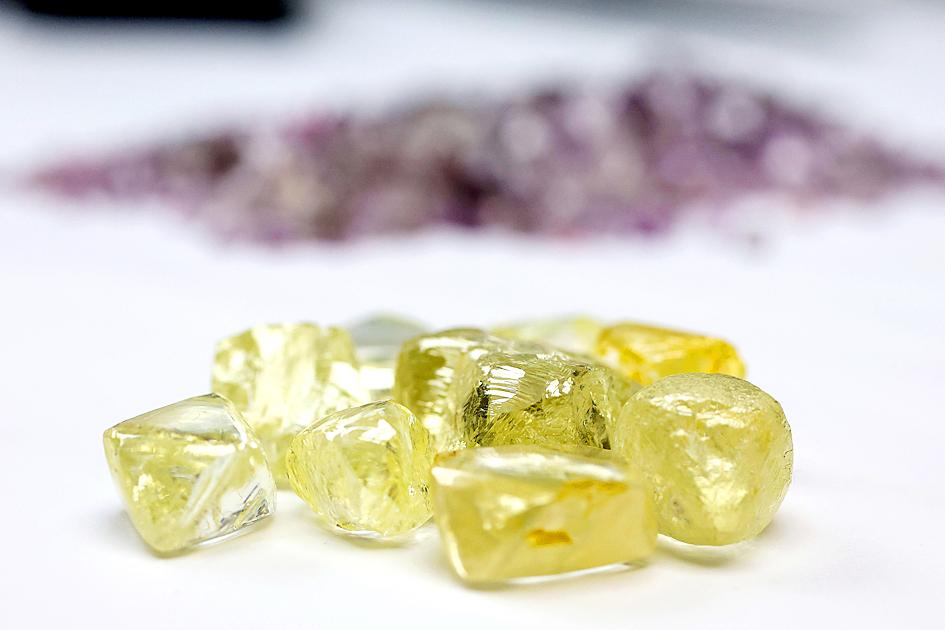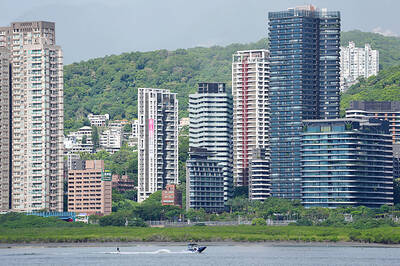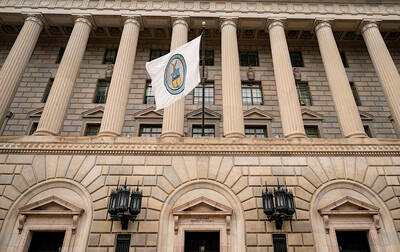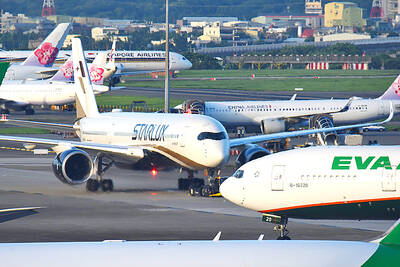In his small office in the Israel Diamond Exchange near the coastal city of Tel Aviv, Pravin Kukadia proudly presents his collection of precious stones.
Between Kukadia’s homeland, India, and his country of residence, Israel, diamonds have forged a key diplomatic and economic link — representing about US$1.5 billion a year and roughly half of all trade between the nations, diamond experts say.
Kukadia first came to Israel in 1996, but soon made regular visits to Israel as a buyer for his family business based in Surat in western India — where 90 percent of the world’s diamonds are cut and polished.

Photo: AFP
“At that time, I bought rough diamonds,” he said, carefully inspecting a particularly rare example, a rose-colored diamond. “I bought small sizes — my specialty was small and cheap.”
Today, the 56-year-old specializes in trading large stones.
In 2003, he moved with his wife and two children to develop his business in Israel, because it was “a major player in the diamond industry” and at the forefront of innovation in the field.
At that time, India “didn’t have the technology like here,” said Kukadia, who imported Israeli technology including laser-machines for his Indian operations.
The Israel Diamond Exchange is home to about 30 Indian companies, making India the foreign nation with the biggest number of firms on the bourse, Kukadia added.
Most Indian diamond families, about 80 people, live close to the diamond exchange in the city of Ramat Gan, and many stay in the same building.
“We are one and the same family,” Kukadia said.
Israeli immigration lawyer Joshua Pex said that Indian diamond traders enjoy a “special status” in Israel, aimed at promoting trade with India.
“Since 2018, they can work and live in Israel indefinitely, and bring their families,” Pex said. “They must renew their visas every three years, compared to two for diamond traders from other countries.”
The huge complex of the diamond exchange is also home to the State Bank of India, the only foreign bank present there, alongside two Israeli banks.
“The diamond industry’s trade with India accounts for about 50 percent of all general trade between Israel and India, representing US$1.5 billion per year,” Israel Diamond Exchange president Boaz Moldawsky said.
Israel sources raw stones from around the world, while many Indian companies specialize in polishing the rocks into gleaming gems.
“We export rough stones, and mainly import polished stones,” Moldawsky said.
While India recognized Israel in 1950, it has traditionally expressed support for the creation of a Palestinian state, and did not establish diplomatic relations with the Jewish state until 1992.
“Diamonds were one of the first commodities exchanged between Israel and India in the early 1970s,” Moldawsky said.
However, bilateral ties go beyond diamonds.
On Thursday, Israeli Minister of Defense Benny Gantz visited India as part of the 30th anniversary of official diplomatic links, where he urged a deepening of defense ties.
Israel sells about US$1 billion of military equipment to India a year.
Cooperation agreements have also multiplied in the fields of water systems, agriculture, health and solar energy.
Other commodities:
‧Gold for August delivery fell US$21.20 to US$1,850.20 an ounce, down 0.38 percent for the week.
‧Silver for July delivery fell US$0.37 to US$21.91 an ounce, declining 0.86 percent weekly, while July copper fell US$0.08 to US$4.47 a pound, but rose 3.71 from a week earlier.
Additional reporting by AP

Taiwan’s rapidly aging population is fueling a sharp increase in homes occupied solely by elderly people, a trend that is reshaping the nation’s housing market and social fabric, real-estate brokers said yesterday. About 850,000 residences were occupied by elderly people in the first quarter, including 655,000 that housed only one resident, the Ministry of the Interior said. The figures have nearly doubled from a decade earlier, Great Home Realty Co (大家房屋) said, as people aged 65 and older now make up 20.8 percent of the population. “The so-called silver tsunami represents more than just a demographic shift — it could fundamentally redefine the

The US government on Wednesday sanctioned more than two dozen companies in China, Turkey and the United Arab Emirates, including offshoots of a US chip firm, accusing the businesses of providing illicit support to Iran’s military or proxies. The US Department of Commerce included two subsidiaries of US-based chip distributor Arrow Electronics Inc (艾睿電子) on its so-called entity list published on the federal register for facilitating purchases by Iran’s proxies of US tech. Arrow spokesman John Hourigan said that the subsidiaries have been operating in full compliance with US export control regulations and his company is discussing with the US Bureau of

Businesses across the global semiconductor supply chain are bracing themselves for disruptions from an escalating trade war, after China imposed curbs on rare earth mineral exports and the US responded with additional tariffs and restrictions on software sales to the Asian nation. China’s restrictions, the most targeted move yet to limit supplies of rare earth materials, represent the first major attempt by Beijing to exercise long-arm jurisdiction over foreign companies to target the semiconductor industry, threatening to stall the chips powering the artificial intelligence (AI) boom. They prompted US President Donald Trump on Friday to announce that he would impose an additional

China Airlines Ltd (CAL, 中華航空) said it expects peak season effects in the fourth quarter to continue to boost demand for passenger flights and cargo services, after reporting its second-highest-ever September sales on Monday. The carrier said it posted NT$15.88 billion (US$517 million) in consolidated sales last month, trailing only September last year’s NT$16.01 billion. Last month, CAL generated NT$8.77 billion from its passenger flights and NT$5.37 billion from cargo services, it said. In the first nine months of this year, the carrier posted NT$154.93 billion in cumulative sales, up 2.62 percent from a year earlier, marking the second-highest level for the January-September